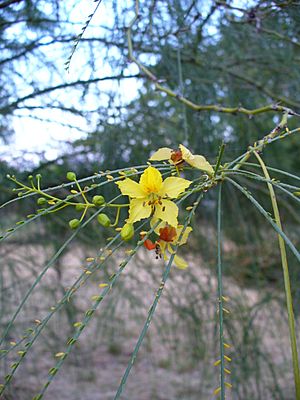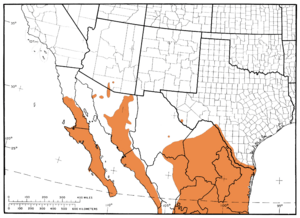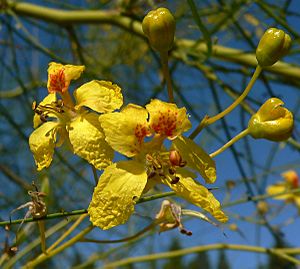Palo verde facts for kids
Quick facts for kids Palo verde |
|
|---|---|
 |
|
| Flowers, leaves and pods | |
| Scientific classification | |
| Kingdom: | |
| (unranked): | |
| (unranked): | |
| (unranked): | |
| Order: | |
| Family: | |
| Genus: |
Parkinsonia
|
| Species: |
P. aculeata
|
| Binomial name | |
| Parkinsonia aculeata |
|
 |
|
| Northern range of Parkinsonia aculeata | |
| Synonyms | |
|
|
Parkinsonia aculeata is a type of flowering plant that grows as a tree or shrub. It belongs to the pea family, called Fabaceae. People know this plant by many names, like palo verde, Mexican palo verde, Jerusalem thorn, and jelly bean tree.
Contents
What's in a Name?
The name Parkinsonia honors an English botanist named John Parkinson who lived a long time ago (1567–1650). The second part of the name, aculeata, is a Latin word. It means 'thorny', which makes sense because this plant has sharp thorns!
The name "Jerusalem thorn" might sound a bit confusing. It actually comes from a mistake in translating a Spanish or Portuguese word, girasol. This word means 'turning toward the sun'.
What Does it Look Like?
Parkinsonia aculeata can be a spiny shrub or a small tree. It usually grows about 2 to 8 meters (6 to 26 feet) tall. Sometimes, it can even reach up to 10 meters (33 feet) high!
This plant can have one main stem or many stems. It has lots of branches with leaves that hang down. The leaves and stems are smooth, without any hairs. The leaves are long, about 15 to 20 centimeters (6 to 8 inches). They have a flat stem with many tiny oval leaflets.
When the weather gets dry, or in winter, these small leaflets often fall off. But don't worry, the green leaf stems and branches can still do photosynthesis. This means they can still make food for the plant using sunlight!
The branches have sharp spines that are about 7 to 12 millimeters (0.3 to 0.5 inches) long. These thorns grow where the leaves meet the stem.
Flowers and Seedpods
The flowers of Parkinsonia aculeata are bright yellow-orange and smell nice. Each flower is about 20 millimeters (0.8 inches) wide. They grow in groups of eight to ten on a long, thin stalk.
Each flower has five petals. Four of them are clear and shaped like a diamond. The fifth petal is longer and has a warmer yellow color with purple spots at its base. Bees help to pollinate these flowers.
This plant blooms in the middle of spring, usually around March to April or September to October. After the flowers, the plant grows seedpods. These pods look like leather and turn light brown when they are ready.
An Invasive Plant
Parkinsonia aculeata is a big problem in Australia. It is listed as one of Australia's worst weeds. It also causes issues in parts of tropical Africa, Hawaii, and other Pacific Islands.
This plant was brought to Australia around 1900. People planted it as an ornamental tree to make gardens look nice and to provide shade. Now, it has spread widely across Western Australia, the Northern Territory, and Queensland. It covers about 8,000 square kilometers (3,100 square miles) of land. It could spread even more in Australia's dry and tropical areas.
Why is it a Problem?
When Parkinsonia aculeata grows in large groups, it forms dense thickets. These thickets make it hard for people, native animals, and farm animals to reach waterways.
The seedpods float, so the plant spreads easily when pods fall into water. They can also be carried downstream by seasonal floods. The seeds need to be scratched or tumbled in streambeds to grow well. Without this, they are slow to sprout.
How is it Controlled?
People use different ways to control P. aculeata in Australia. They have brought in three types of insects to help. These are called biological control agents.
- The parkinsonia bean weevils, Penthobruchus germaini and Mimosestes ulkei, are very helpful. Their larvae (young insects) eat only the seeds from the parkinsonia pods.
- The parkinsonia leaf bug, Rhinacloa callicrates, damages the plant's leaves. However, it hasn't had a big impact on the plant overall.
Other methods include using fire for young trees. People also remove the plants using machines or spray them with herbicides.
Where Does it Grow?
P. aculeata is native to the deserts of the southwestern United States. This includes western Texas, southern New Mexico, and southern Arizona. It also grows naturally in northern Mexico (in the states of Sonora and Chihuahua) and the Galápagos Islands.
Over the past few decades, its native range has grown into central Texas. Humans have also moved it to the Caribbean, South America (as far south as northern Argentina), and Hawai'i. It has also been introduced in Europe and is very common in Australia.
This plant does not grow well in places where the temperature drops below -6 degrees Celsius (20 degrees Fahrenheit). It has spread into Southern California, reaching as far north as San Bernardino County.
Where it Likes to Live
Parkinsonia aculeata can handle very dry conditions. If there isn't much water, it just grows shorter. But in places with more moisture and rich soil, it becomes a taller, spreading shade tree.
This plant loves lots of sunshine. It can grow in many types of dry soils, like sand dunes, clay, or chalky soils. It can be found from sea level up to 1,500 meters (4,900 feet) high.
What is it Used For?
In Mexico, people soak the leaves of Parkinsonia aculeata to make a medicine. This medicine is used to help with fever and epilepsy.
Farm animals usually do not eat the leaves of this plant because of its sharp spines.
Gallery
See also
 In Spanish: Parkinsonia aculeata para niños
In Spanish: Parkinsonia aculeata para niños








